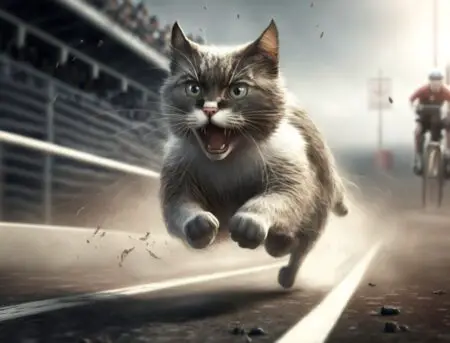Ever wondered if a cat has ever journeyed into space? Well, believe it or not, there was indeed a feline astronaut and her name was Félicette. As the first and only cat to reach the cosmos, her mission back in the 1960s was truly out of this world.
The Space Race between the United States and the Soviet Union may have grabbed most of the headlines, but France made its own unique contribution to this historic era of space exploration. Rather than sending a man or a monkey, they chose Félicette, a fluffy, wide-eyed Parisian stray. The mission catapulted her into the annals of space history, and her story serves as a fascinating and unusual chapter in the chronicles of space travel.
So buckle up as we embark on this captivating journey, tracing the pawprints of Félicette from the streets of Paris to the starry expanses of outer space.
Ready to explore this purr-fectly remarkable tale? Well then, let’s get started!
Setting the Scene: The Space Race of the 1960s
The Space Race was an iconic period of the Cold War, marked by fierce competition between the United States and the Soviet Union.
Both superpowers were eager to demonstrate their technological prowess and the superiority of their political systems.
But amid this grand geopolitical contest, a smaller, lesser-known story was taking place. With a stray cat at the helm, the French were making their unique mark on space history.
Félicette: The Unlikely Astronaut and Her Selection Process
But why a cat, you might wonder? The decision wasn’t random. Félicette, a petite Parisian stray with black and white fur, was chosen from a group of about a dozen potential feline astronauts. The selection criteria were quite specific.
The candidates needed to be small, calm under pressure, and capable of enduring the physical rigors of a space journey. After rigorous testing and training, it was Félicette who stood out from the crowd. Her calm demeanor and adaptability made her the perfect choice for the mission.
What Happened to Felicette in Space? (Video)
The Launch: Félicette’s Historic Journey to the Stars
On October 18, 1963, with a global audience watching with bated breath, Félicette was secured inside a special capsule atop the French Veronique AG1 rocket. As the rocket roared to life and soared into the sky, Félicette was on her way to making history.
The journey, though brief, was monumental. Félicette traveled about 100 miles above Earth, experiencing about five minutes of weightlessness before the capsule descended back to Earth.
Technological Aspects of Félicette’s Mission
Félicette’s mission was no simple task—it was a marvel of technology and scientific understanding. The capsule housing Félicette was specially designed for her safety and comfort. It included temperature regulation to maintain a comfortable environment and was equipped with instruments to monitor her vital signs during the flight.
Data about her heart rate, blood pressure, and other physical responses were transmitted back to Earth, providing invaluable insights into how space travel might affect living creatures.
Despite the primitive technology of the 1960s, Félicette’s journey was a significant accomplishment and contributed to the advancement of space exploration.
Comparing Félicette’s Mission to Other Animal Astronauts
Before Félicette’s ground-breaking mission, there had been other non-human astronauts. Most notably, the Soviet Union had sent Laika, a dog, into orbit. However, unlike Félicette, Laika’s journey was a one-way trip.
The United States also made its contributions, sending a series of monkeys and apes into space. But Félicette was unique – she was the first and remains the only cat to have journeyed to space. Her mission added a new chapter to the story of animal astronauts, broadening our understanding of how different species might respond to the rigors of space travel.
The Science Behind Félicette’s Journey: Understanding the Impact of Space Travel on Living Beings
The data gathered from Félicette’s mission was priceless. Scientists were interested in how the stress of take-off, the experience of weightlessness, and the heat of re-entry might affect a small mammal.
Félicette’s vital signs were carefully monitored throughout the journey, offering valuable insights. Thanks to her, we better understood how living creatures could withstand the rigors of space travel – information that would prove crucial as humans prepared for their journeys to the stars.
Return to Earth: Félicette’s Re-entry and Recovery
Félicette’s journey to space was short-lived, lasting only around 15 minutes from take-off to landing. After a brief period of weightlessness, her capsule began its descent. The spacecraft’s parachutes deployed successfully, and Félicette touched down safely back on Earth.
Despite the rigors of the journey, Félicette appeared to be in good health, and the mission was hailed as a success.
Significance and Legacy of Félicette’s Space Travel in Space Exploration
Félicette’s voyage to the stars wasn’t just a quirky footnote in the annals of the Space Race – it played a significant role in advancing our knowledge of space travel. The data her journey provided helped scientists understand more about space travel’s physical and mental impacts on living beings.
This information was critical as space agencies prepared for human spaceflight. Though Félicette’s name may not be as well-known as some human astronauts, her contribution to space exploration is no less important. Her legacy continues to inspire curiosity and the spirit of exploration, reminding us that even the smallest among us can reach for the stars.
Remembering Félicette: Tributes and Memorials
Over the years, Félicette has received numerous tributes that honor her contribution to space exploration. In 2019, a successful Kickstarter campaign funded a bronze statue of Félicette, which now stands at the International Space University in Strasbourg, France.
Additionally, she has been commemorated on postage stamps and featured in several books and documentaries. These tributes serve as reminders of her unique journey and the important role she played in the history of space exploration.
The Lasting Impact of Félicette’s Mission on Modern Space Travel
Félicette’s legacy lives on in the field of space travel. The knowledge gained from her mission has been instrumental in shaping the direction of human spaceflight.
The physiological data gathered during Félicette’s journey contributed to a greater understanding of how living organisms handle the stress of space travel, informing safety protocols and mission planning for human astronauts.
Even as we continue to reach for new frontiers in space exploration, from Mars to beyond, we owe a debt to Félicette, the remarkable cat who proved that the sky is not the limit.
The First Animal in Space May Surprise You (Video)
"In ancient times cats were worshipped as gods; they have not forgotten this."
-- Terry Pratchett





